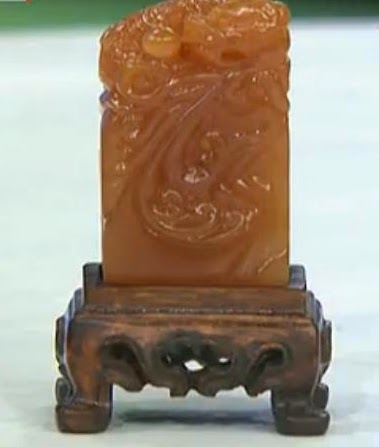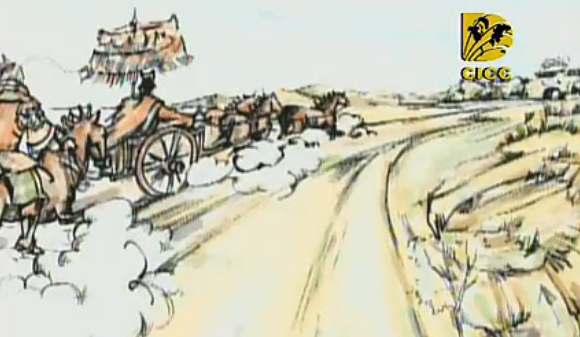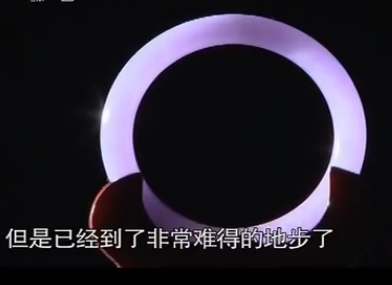There is a teapot on display in a folk museum in Shanghai which is priceless. Even if you were to offer 200 million dollars, the owner would not sell it. When teapot makers from Yixing visit the museum, they would kneel in front of the teapot and pay their respect. Some would secretly take a photo or make some measurement hoping to make an exact duplicate of it. Others don't mind paying 20 000 dollars just to touch it. So, what sort of teapot is it? Why is everybody so mad about it?
 |
| Potter kneel in front of a pot |
 |
| Paying respect to a pot? |
This is a teapot made by the legendary Shao Dahen during the mid-Qing dynasty. In the County Annals of Yixing, it was written that teapots by Shao Dahen were rare and priceless as there were very few of his teapots left behind. He was considered the best potter ever lived in Yixing. Even the grandmaster Gu Jingzhou had deep respect and admiration for his works.
 |
| Figurine of Shao Dahen by Xu Siewtang |
 |
| County Annals of Yixing |
 |
| Shao Dahen's Duozhi pot |
So who actually owns this teapot? Why is it so special?
There was a rumour that a certain Pan family in Yixing had in their possession a mysterious pot by Shao Dahen, passed down from 3 generations. The pot was acquired from a certain magistrate during the Qing dynasty. Xu Sihai, a navy officer, heard the news and immediately went to the Pan family to take a look. Xu was a famous collector and he was truly mad about teapots until his friends called him the teapot addict. He once spotted a Qing dynasty teapot on a roadside stall and the seller wanted 500 dollars for it (as he knew Xu was an officer, had to be rich), unfortunately he only had 200 dollarsin his wallet. Immediately he removed a newly bought Swiss watch from his wrist and gave it to the seller. The seller was still not satisfied, he then removed a sweater which he was wearing (100% wool and newly knitted by his wife) and gave it to the seller. With that he was finally able to buy the teapot he spotted (imagine how is life without the warm clothing in winter, no wonder he was also called the teapot crank).

When Xu reached the house of the Pan family, he saw the teapot on display on a table. The owner would not allow him to touch the teapot. As he walked around the table and examined the teapot in every direction possible, he was sweating profusely due to excitement and joy. The king of all teapots was really awesome. As he described it, the teapot was so well made that every dimension is accurate and perfect, not a bit too much nor too little (in his own words). You could look at it at any angle and it would still look awesome and perfect. Critics said that the legendary Gu Jingzhou made two similar teapots and yet they were no match to this one (Gu himself admitted that his pots were no way near this perfect one).
When Xu asked for the price, it was a hefty 30000 dollars. In the 60s, that was indeed an incredible sum. As Xu was only an army officer earning tens of dollars a month, the sum of 30000 dollars looked impossible to him. Yet, in his heart this was a teapot he had to collect no matter the cost. Eventually he bargained down to 23000 dollars plus some paintings and calligraphy work. He must have sold his house and borrowed heavily to raise funds for this teapot. Don't forget his nicknames, teapot addict and crank, he would everything to achieve this goal of owning the king of all pots.
After he bought the teapot by Shao Dahen, everybody came to his house to have a look at the king of all pots. That created a stir in the local media. Immediately a Taiwanese businessman offered Xu 100 thousand US dollars to buy the teapot. 3 months later, an American offered him 3.6 million yuens to have the teapot. At that time with 3 million dollars, one could easily buy 3 bungalows in downtown Shanghai. Xu was not tempted by this huge financial gain as he regarded the teapot as belonging to the people of China and he would not let it leave the nation. Of course now the price has increased to 200 millions and yet he had no intention of selling it as he considered it to be priceless because of its historical value (Gu Jingzhou's pots are already selling for more than 10 millions in auction markets).
In the 80s, he quited his army career and learned art from an artist Tang Yun. He began to make teapots in Yixing and even won a gold medal in 1985 for a pot he designed and made (the pot is now in a museum in San Fransisco).
 |
| Tang Yun inscribed on a pot made by Xu |
He had collected over 1200 fine Yixing teapots from the Ming dynasty to the Republic Era (post 1911). In 1987, he opened his own museum in Shanghai and housed all his collection in it. Of course, the flagship of the museum is the teapot by Shao Dahen (the Duozhi Pot) where teapot lovers from all corners of the world would one day want to come and see this wonderful work of art, a master piece.
Today, Xu Sihai is still busily making teapots. He teams up with renown artists and calligraphers to produce artistic teapots for the Shanghai Expo and the Beijing Olympics. As he said he needs to sell teapots to raise funds for his only passion in this world - to collect more and more Yixing teapots for display in his folk museum.
 |
| His early work on display in the Yixing factory. |
 |
| A dog by Xu Sihai |

许四海: 字紫云,1946年生,盐城人。师从国画大师唐云,作品“夏意”获国家金牌奖。与多位书画名家合作的“海春壶”“寿翁壶”“啸天壶”和“云海壶”堪称一绝,并为“八运会”“香港回归”“上海国际茶文化节”等特制专用茶壶。1989年新加坡成功举办个人作品展,号称江南壶怪。许四海是一位在海内外享有盛誉的紫砂陶艺大家,也是一位极富传奇色彩的鉴藏家。
一套向2010年上海世博会献礼的紫砂“世博汉字壶”于2010年2月18日在沪面世,传承中华数千年历史的汉字与中国传统手工紫砂工艺珠联璧合而成为精品茗具。中国世博纪念品研发工作室与素有“
江南壶怪”
 |
| Another Shao Dahen's pot (in a museum in Hong Kong) |



.jpg)
.jpg)







.jpg)
.jpg)


.jpg)
.jpg)
.jpg)
.jpg)
.jpg)
.jpg)
.jpg)
.jpg)
.jpg)
.jpg)
































